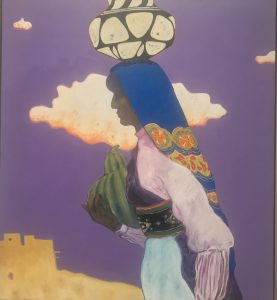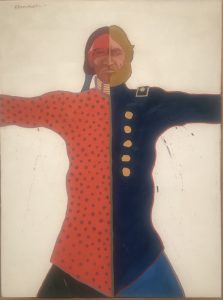
By Carolann Lowe
The National Museum of the American Indian held a press preview on Thursday of the At the Edge of America exhibit, featuring the work of the Native American artist T.C. Cannon. Cannon explores the activism and creative expressions that defined America in the 1960s and 1970s. The exhibit displays Cannon’s paintings, sketches and poetry. A guitarist and sings, his music is played in the background.
Cannon, in his art, confronts biases of the dominant Western culture. His art reveals how Native Americans persisted and even flourished, a truth that he and others feel has been absent from American and art history. Canon’s work is also a powerful reclamation of America as an Indian country.
Native people have not only been absent in art and history, but when they appear they are misrepresented. This has been true for centuries. Cannon disrupts historical portrayals.

One of Cannon’s paintings showing this disruption is the “Cloud Madonna.” The Virgin Mary is associated with Christianity and embedded in Western religious beliefs. Cannon visualizes the Virgin Mary as a brown skinned woman wearing a blue mantle. She is seen holding a melon as opposed to an infant child, and her water jar serves as her halo.
Cannon’s artwork urges the viewer to reflect on the contradictions of the Native Americans’ place in American history. Much is unknown to most of the country: Forty two thousand Native Americans served in the Vietnam War from 1964-1975, for example. Following Cannon’s completion of art school, he served as a soldier in the Vietnam War.
Many American Indians have viewed their participation in the U.S. armed forces as continuation of the warrior’s role in their native culture. He is proud to have served as an American warrior.

Leave a Reply
You must be logged in to post a comment.